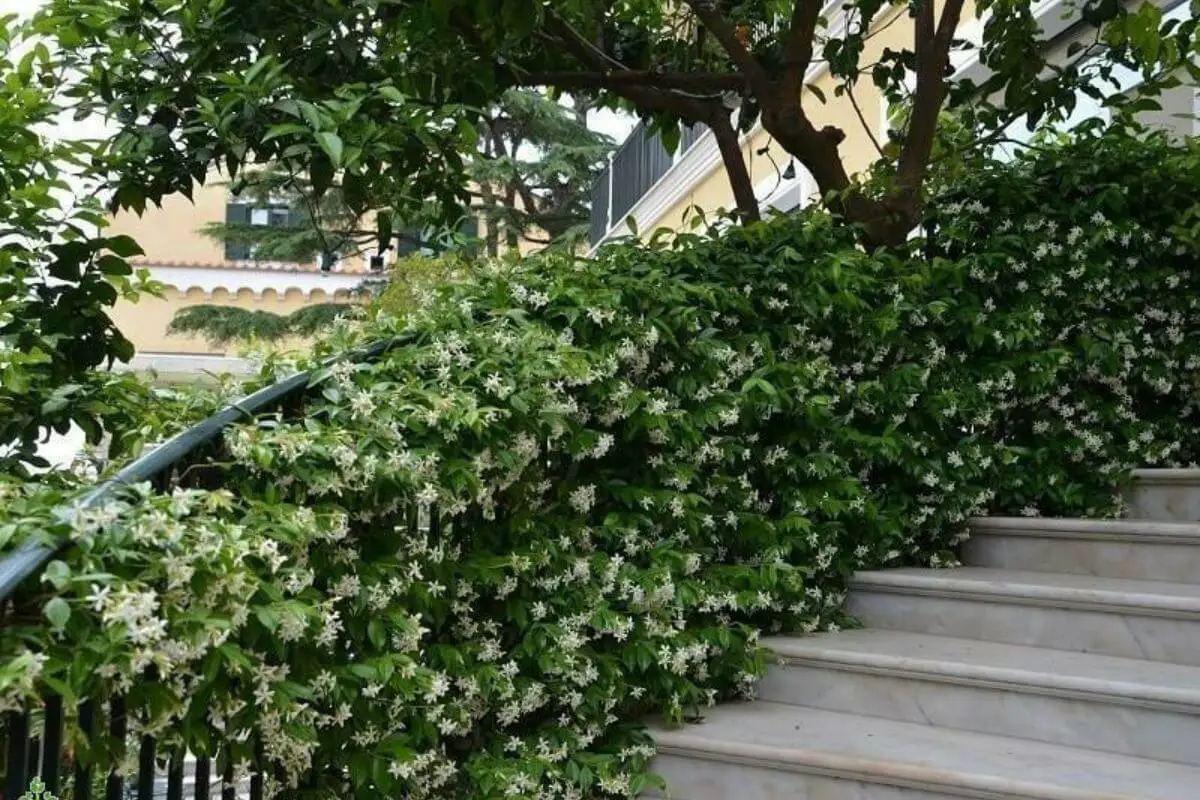Introduction
Gardens and outdoor spaces come alive with the enchanting presence of flowering vines. Among these, two popular choices stand out: Pink Jasmine and Star Jasmine. With their captivating fragrance and stunning blossoms, they add beauty and aroma to any landscape. In this article, we’ll delve into the differences and unique characteristics of Pink Jasmine and Star Jasmine, helping you make an informed decision when it comes to choosing the perfect vine for your garden.
Meet Pink Jasmine
Pink Jasmine (Jasminum polyanthum), also known as Chinese Jasmine, is a vigorous climbing vine cherished for its profusion of pink blossoms. Native to China, this variety is celebrated for its captivating fragrance, especially during the spring months. Its small, star-shaped flowers create a stunning visual display against its glossy green foliage.

Discover Star Jasmine
Star Jasmine (Trachelospermum jasminoides), often referred to as Confederate Jasmine, is another popular choice among gardeners. Hailing from Southeast Asia, this vine is prized for its small, white, star-shaped flowers that emit a sweet, delicate scent. Its glossy leaves provide an elegant backdrop for the blossoms, adding to its overall charm.
Comparing Fragrance and Blossoms
While both Pink Jasmine and Star Jasmine offer delightful fragrances, they differ in their floral appearance. Pink Jasmine boasts clusters of pink flowers with a slightly spicy undertone in its scent. Star Jasmine, on the other hand, presents pristine white blooms with a sweeter aroma. The choice between the two could hinge on personal preference, whether you lean towards the warmth of pink or the purity of white.
Growing Conditions for Pink Jasmine
Pink Jasmine thrives in well-draining soil and prefers full sun to partial shade. It’s a fast grower that can reach impressive heights if left unpruned. Its rapid growth makes it an ideal choice for covering trellises, fences, or pergolas.
Caring for Star Jasmine
Star Jasmine prefers a similar environment, flourishing in well-draining soil and ample sunlight. It’s a versatile vine that can be trained to climb or sprawl, making it a suitable option for ground cover or vertical growth.
Pink Jasmine or Star Jasmine: Making the Choice
Choosing between Pink Jasmine and Star Jasmine boils down to factors like color preference, fragrance, and growth habit. If you’re drawn to the elegance of white blooms and a sweet aroma, Star Jasmine might be your choice. On the other hand, if you’re captivated by the allure of pink blossoms with a hint of spice, Pink Jasmine could be the one for you.
Aesthetic Uses of Both Varieties
Both Pink Jasmine and Star Jasmine have aesthetic uses beyond their blossoms and fragrance. They create a lush and inviting atmosphere in gardens, and their climbing nature can be harnessed to transform plain structures into picturesque focal points.
Creating a Fragrant Garden Oasis
Imagine strolling through your garden enveloped in the intoxicating fragrance of jasmine. By strategically placing Pink Jasmine and Star Jasmine, you can create pockets of scented beauty that turn your outdoor space into a fragrant oasis.
The Allure of Climbing Vines
Climbing vines like Pink Jasmine and Star Jasmine offer more than just visual appeal. They contribute to the overall ecosystem by providing shelter and nesting spots for birds and insects, enhancing the biodiversity of your garden.
Exploring Jasmine in Culture and History
Jasmine holds cultural significance in various parts of the world. It has been revered for centuries, symbolizing love, purity, and good luck in different cultures. Its history is woven into folklore, art, and even religious practices.
The Symbolism of Jasmine
Jasmine’s symbolism varies across cultures. In some traditions, it represents sensuality and romance, while in others, it signifies hope and new beginnings. Understanding the symbolic meanings can deepen your appreciation for these enchanting vines.
Tips for Planting and Maintenance
- Choose the Right Location: Ensure your chosen spot receives the right amount of sunlight.
- Pruning Matters: Regular pruning helps maintain the shape and health of the vines.
- Provide Support: Both Pink and Star Jasmine need support for climbing, so install trellises or arbors.
- Watering Routine: Keep the soil consistently moist, especially during the growing season.
- Fertilize Wisely: Use a balanced fertilizer to encourage healthy growth and flowering.
Common Mistakes to Avoid
- Overwatering: Excess moisture can lead to root rot, so avoid waterlogging the soil.
- Ignoring Pruning: Regular pruning prevents the vines from becoming tangled and promotes better blooming.
- Planting Too Deep: Plant at the same depth as the container to prevent the roots from suffocating.
Conclusion
Pink Jasmine and Star Jasmine, with their distinctive fragrances and captivating blooms, bring a touch of elegance to gardens and outdoor spaces. Whether you’re drawn to the rosy charm of Pink Jasmine or the delicate allure of Star Jasmine, both vines have the power to transform your landscape into a scented paradise. As you embark on your journey of selecting and nurturing these enchanting plants, remember that each one carries its own unique beauty and contribution to the world of gardening.
FAQs
Can Pink Jasmine and Star Jasmine grow together?
Yes, they can grow together, creating a visually appealing mix of colors and scents.
Do these jasmines require a lot of maintenance?
While they do require some care, their stunning blooms and fragrances make the effort worthwhile.
Can Pink Jasmine and Star Jasmine be grown indoors?
With proper care, they can be grown indoors near a sunny window or under suitable artificial lighting.
How often do these jasmines bloom?
Pink Jasmine typically blooms in spring, while Star Jasmine can bloom throughout the warmer months.
Are these jasmines attractive to pollinators?
Yes, their fragrant blossoms can attract bees and other pollinators to your garden.



